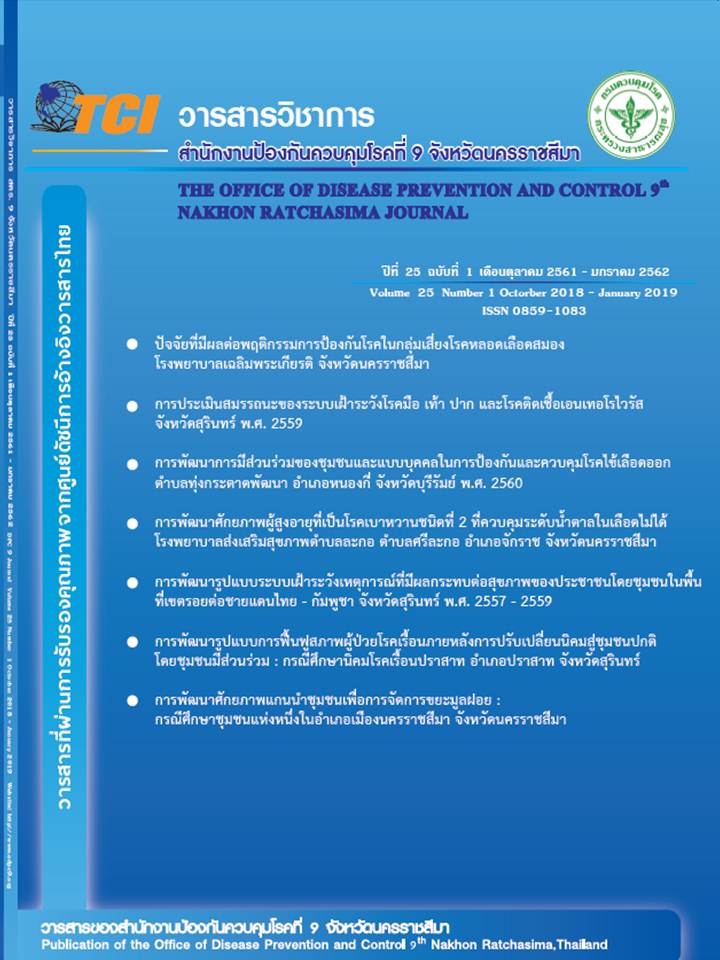Community Participation Development and Role Model on Dengue Hemorrhagic Fever Prevention and Control in Thungkratadphattana, Nongki District, Burirum Province A.D. 2017
Keywords:
Role model, Participatory planning, Deming’s cycleAbstract
This participatory action research aimed to develop the prevention and control of DHF using
community participation and the role model. The study was implemented in Thungkratadphattana
Sub-district, Nongki District, Burirum Province, which was divided into 3 phases in studying the
community context, the process development and its results of the development. There were fty-two
informants consisted with forty of the resident representatives, one of each the community health
of cer, teacher and leader, seven of village health volunteers and two of the municipal council members.
Qualitative data were collected by activity record and observation forms and a group discussion,
and quantitative data were collected using a household index and a questionnaire of knowledge,
awareness and community participation of DHF prevention and control. This study was conducted
in April to July 2017. Content analysis of triangulation method was used for qualitative data and
descriptive statistics and paired t-test were used for comparing mean scores of the quantitative data
between before and after the development process. A result of the community context study was found
that the local residents still lack of the awareness toward the disease prevention and control, activities
remains to the burden of the village health volunteers and community leaders. For the development
process with participatory planning of AIC and Deming’s cycle (PDCA), three community projects
were required: (1) mosquito free in villages and schools, (2) providing knowledge about DHF
in the community and (3) neighbor-led aid for mosquito free. By the results had occurred from the
community thinking and participation and including its practices for the disease prevention and control.
The role model. It can be enhanced to prevent and control the disease. When comparing the differences
in mean scores of the knowledge, awareness and participation on DHF prevention and control, it was
found that after the development, the mean scores in the disease prevention and control were signi cantly
increased (P<0.001, P<0.001 and P<0.001, respectively). In comparing the household index (HI)
of the high prevalence of the disease in June of the year of 2016 was amounted from 18.2 and
decreased to 9.1 in June of the year of 2017. This revealed that the development of disease prevention
and control by community participation and personalization presenting can promote Dengue prevention
and control effectively.
References
go.th/549.htm [20 กุมภาพันธ์ 2560].
2. สำนักงานสาธารณสุขจังหวัดบุรีรัมย์. รายงาน 506 สถานการณ์โรคไข้เลือดออกปีงบประมาณ 2559.
บุรีรัมย์ : สำนักงานสาธารณสุขจังหวัดบุรีรัมย์, 2559
3. โรงพยาบาลหนองกี่. รายงาน 506 สถานการณ์โรคไข้เลือดออกปีงบประมาณ 2559: โรงพยาบาลหนองกี่,
2559
4. ไชยรัตน์ เอกอุ่น. รูปแบบการแก้ปัญหาโรคไข้เลือดออกโดยการมีส่วนร่วมของประชาชนในเขตตำบล
โพนทอง อำเภอสีดา จังหวัดนครราชสีมา. วารสารวิจัยและพัฒนาระบบสุขภาพ 2557 ; 7(3) : 64-71.
5. สมนึกตกค้าง. การพัฒนางานด้านการป้องกันและควบคุมโรคไข้เลือดออกขององค์การบริหารส่วนตำบล
อ่าวน้อย อำเภอเมือง จังหวัดประจวบคีรีขันธ์.รายงานการศึกษาอิสระปริญญารัฐประศาสนศาสตร
มหาบัณฑิตสาขาการปกครองท้องถิ่นวิทยาลัยการปกครองท้องถิ่น มหาวิทยาลัยขอนแก่น, 2555.
6. สุดาปนีย์ เอื้องคำประเสริฐ. การพัฒนาการมีส่วนร่วมของชุมชนในการป้องกันและควบคุมโรคไข้เลือดออก
บ้านโนนเมือง ตำบลโนนเมือง อำเภอขามสะแกแสง จังหวัดนครราชสีมา. วิทยานิพนธ์สาธารณสุขศาสตร
มหาบัณฑิต สาขาวิชาพัฒนาสุขภาพชุมชน บัณฑิตวิทยาลัย มหาวิทยาลัยราชภัฏนครราชสีมา. 2556.
7. กรรณิการ์ อุดมกัน. การพัฒนาศักยภาพของชุมชนในการป้องกันและควบคุมโรคไข้เลือดออกบ้านนาซ่อม
หมู่ที่ 4 ตำบลท่าเรือ อำเภอนาหว้า จังหวัดนครพนม.วารสารศูนย์บริการวิชาการ มหาวิทยาลัยขอนแก่น
2556 ; 3(4) : 10-16.
8. สุวคนธ์ผุดผ่อง. การป้องกันและควบคุมโรคไข้เลือดออกโดยการมีส่วนร่วมในชุมชนบ้านทุ่งแต้หมู่ 1
ตำบลทุ่งแต้อำเภอเมืองจังหวัดยโสธร. วารสารพยาบาลศาสตร์และสุขภาพ 2555 ; 35(3) : 72-79.
9. Rogers, R.W. “A pretection Mativation Theory of Fear Appeals and Attitude Change”. The
Journal of psychology 1975 ; 91(23) : 99.
10. มาตุภูมิ พอกระโทก. การพัฒนาการมีส่วนร่วมของชุมชนในการเฝ้าระวังและป้องกันโรคไข้เลือดออก
โดยกระบวนการเสริมพลังอำนาจ ตำบลด่านเกวียน อำเภอโชคชัย จังหวัดนครราชสีมา. วารสาร
ราช พฤกษ์ 2557 ; 12(3) : 123-131.
11. ธนกฤต ชูคันหอม. การพัฒนารูปแบบการป้องกันและควบคุมโรคไข้เลือดออกโดยชุมชนมีส่วนร่วม
ตำบลโคกพระ อำเภอกันทรวิชัย จังหวัดมหาสารคาม.วารสารวิทยาศาสตร์และเทคโนโลยี มหาวิทยาลัย
มหาสารคาม.2558 ; 34(4) : 358-365.
12. สุวัฒน์ เรกระโทก. การพัฒนารูปแบบการมีส่วนร่วมของชุมชนในการป้องกันและควบคุมโรคไข้เลือดออก
ของประชาชนในเขตพื้นที่สถานีอนามัยหนองใหญ่ ตำบลห้วยบง อำเภอด่านขุนทด จังหวัดนครราชสีมา.
วารสารราชพฤกษ์ 2553 ; 8(2) : 159-164.

Downloads
Published
How to Cite
Issue
Section
License
บทความที่ลงพิมพ์ในวารสารวิชาการสำนักงานป้องกันควบคุมโรคที่ 9 จังหวัดนครราชสีมา ถือว่าเป็น
ลิขสิทธิ์ สำนักงานป้องกันควบคุมโรคที่ 9 จังหวัดนครราชสีมา



